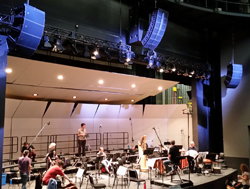Capilano University’s BlueShore Financial Centre for the Performing Arts is intimate and well proportioned for this mid-sized liberal-arts university in North Vancouver.
Now, thanks to its recent upgrade to new L-Acoustics loudspeakers installed by AV systems integrator Solotech Vancouver, the busy campus arts venue feels even more intimate.
“The BlueShore at Cap,” as it’s known, hosts a wide range of events, from theatrical productions to concert performances by the school’s music department and touring artists, including Buffy Saint-Marie, Randy Brecker and Harry Manx.
Prior to the system retrofit, the venue’s popularity with the community and visiting artists was pushing its basic PA system past its limits, and the school’s own ambitions for the space demanded a sound system that could cover all of the artistic territories the theater, jazz and music departments had staked out.
Today, that mission has been accomplished in the form of a new L-Acoustics system comprised of Kara(i), ARCS WiFo and 8XTi elements, which Solotech’s Larry Darling specified with critical input from those who are intimately familiar with the venue’s needs.
“We wanted to make sure that the theater’s system would satisfy the needs of both the university’s theater and music departments,” says Andy Horka, an instructor who teaches sound design at Capilano University as well as serves as the resident sound designer for the Richmond Gateway Theatre and touring sound engineer for past shows like Rent, Riverdance and Annie Get Your Gun.
Horka says he first encountered L-Acoustics speakers over 15 years ago in Orlando where he did the sound design for a production of Ben Hur: The Musical. “It was the V-DOSC system at that time, and it was very unconventional to see a touring system in a theater,” he says. “But when I heard it, I fell in love with that sound.”
Horka worked with the theater’s production technician, Brian Morrison, and Lawrence Wu, also an instructor at Capilano University’s music department and a live sound engineer whose music credits include 12 years as the technical director for the Canadian Rocky Mountain Festival. Together, they designed a system with L-Acoustics and Solotech that could easily accommodate both musical and theatrical productions and keep the school at the leading edge of venue sound.
The result is a system that features seven Kara(i) speakers flown in front of three SB18i subwoofers in a center array, with eight ARCS WiFo speakers positioned four per side as side fills. However, Horka points out that the entire system is largely based around the use of five coaxial 8XTi speakers used as front fills and arrayed across the front of the stage, and just below it, in custom-built soffits. These speakers are precisely aimed and time-aligned to produce imaging that keeps the sonic focus on the stage.
“By positioning these front-fill speakers this way, we achieve a more effective overlap and much better imaging,” he says. “All front-fill speakers are timed back to the intersect point [in the center of the stage]. Combined with the rest of the system, the coverage in the theater is incredibly even and consistent, for any type of sound.”
That kind of even coverage also allows the system to produce substantial SPL, but at the same time not overwhelm the audience. “When we were ringing out the system we measured the sound at about 112 dB at the front of house position,” he recalls, “yet we were able to carry on a normal conversation. The music was crystal clear. No distortion whatsoever. Just great sound.”
The sound designer says the Kara(i) boxes were especially good for a theater like this. “It’s a big box for a room of this size but it gives us the coverage and SPL we need, but without any of the cabinet resonance that other speakers can produce,” he explains. “The Kara(i) has absolutely no cabinet honking at all.”
Horka complimented more than the L-Acoustics’ sound; he also noted how the Soundvision software’s acoustical simulation, real-time mapping in coverage and delay modes, and user-friendly 3D graphic interface helped Solotech precisely position each speaker.
And while the L-Acoustics system was able to address all of Horka’s needs for theater applications, the music department had its own requirements. “The theater has wood walls, so we needed the new system to have a high degree of directionality in order to keep the sound energy off the walls and on the seating area,” explains Capilano’s Lawrence Wu. “The L-Acoustics system has excellent directionality, so we’re getting coverage exactly where we need it.”
Wu describes that the system also meets another critical requirement, which calls for the ability to use either the center cluster, side fills or front fills alone—or in any combination—to meet the needs of a wide variety of musical artists. “Some of the artists really just need minimal amplification, and with this system we can use the Kara(i) speakers in the center cluster, or the side ARCS WiFo speakers on their own,” he says. “That kind of flexibility was only available from L-Acoustics.”
And people have truly noticed the theater’s new sound. “We get lots of comments now—positive comments,” Horka adds. “In fact, Martha Redbone recently performed here and she even mentioned it from the stage. And the audience applauded! Imagine—the audience applauding the sound system. Then you know you’ve done it right.”




















